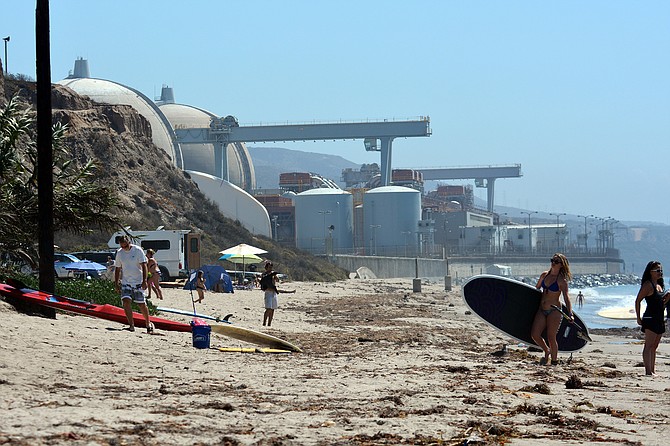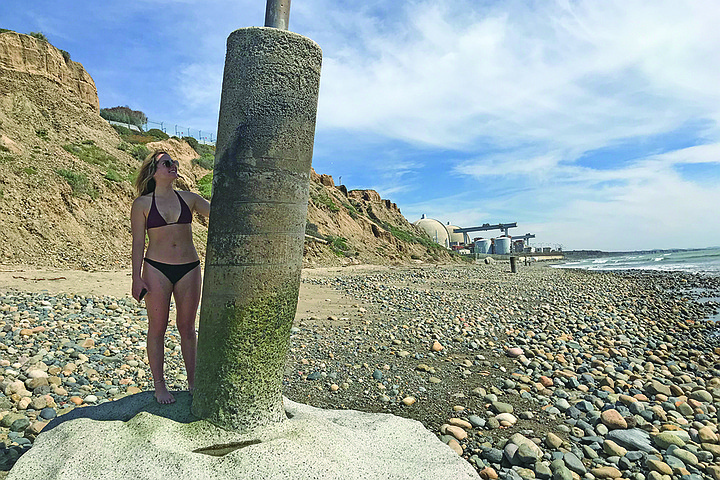 Facebook
Facebook
 X
X
 Instagram
Instagram
 TikTok
TikTok
 Youtube
Youtube

San Onofre Nuclear Generating Station may be retired, but to many area residents, it's a sleeping giant.
In July, it stirred. That's when its operator, Southern California Edison, was allowed to resume loading spent nuclear fuel into dry storage onsite, almost a year after a filled canister got stuck going down, and for 45 minutes, dangled 18 feet in the air.
Solana Beach, Carlsbad, and now Del Mar have leaped to pass resolutions that call for the state's help with their concerns and to put an end to the loading until certain safety conditions are met. "We're all in the risk zone," warned Del Mar councilmember Dwight Worden at the Sept 30 city council meeting.

But a new phase of decommissioning is coming. Once the irradiated fuel has been transferred to dry storage, Edison proposes to dismantle units 2 and 3, along with the spent fuel pool. And this, too, is risky.
According to a Coastal Commission staff report, a lot of foundation and other material would be covered with backfill. "Over time, coastal processes, exacerbated by sea level rise, could cause portions of remaining structures to become exposed, which would cause potential risk to public safety and marine life, as well as impacts to visual resources and public access."
The commission will recommend several conditions before approval of the permit.
Worden said the federal government was supposed to provide a long-term storage facility for the 3.6 million pounds of radioactive waste now in limbo. The casks and cooling pools weren't meant for the long haul. Edison "is putting the spent fuel in these casks and burying it down on the beach, basically in concrete."
Thirty-one canisters have been entombed in the storage vault and 42 more await transfer. A timeline says all of the waste was expected to be in dry cask storage by mid-2019.
It's the thin stainless steel casks, reportedly subject to gouging, that have caused the biggest uproar.
Del Mar's resolution calls for canister loading to be stopped until there is a loading and transfer system in place that meets requirements such as regular inspection of canisters, and stops using the thin-walled ones.
"We know from NRC reports that they are scratched and gouged as they are lowered into the storage cavity," said Cathy Iwane, a nuclear activist who lives in Del Mar. "Sea rise and naturally occurring water tables threaten to swamp and corrode" the 5/8" thick canisters.
"Of all the families living in Del Mar, I would venture that mine is the only one that has relocated after a nuclear disaster," Iwane said. She fled Japan after the Fukushima nuclear disaster in 2011.
"San Onofre is just as vulnerable to earthquakes and tsunamis."
Southern California Edison says it couldn't happen here because San Onofre, unlike Fukushima, is non-operational. And all that highly radioactive waste is safely contained, unable to breach the boundaries of the site.
When Solana Beach passed their resolution, representatives for the plant claimed that it was full of errors.
Like the other cities, Del Mar supports moving the waste inland, above the swirling seas. But since there is no such safe spot awaiting, and questions about the casks, and the risks of moving the waste to thicker canisters, tighter rules seem like the only way to help.
According to the Nuclear Regulatory Commission's timeline, the plant is now in the early phase of decontamination and dismantlemant, expected to last several more years. The final restoration work has to be done within 60 years, when its license is up.
"What seems inevitable is that San Onofre's waste, only 35 miles from here, will be stranded for generations at its oceanfront vault, exposed and vulnerable to the forces of man and nature," Iwane said.


San Onofre Nuclear Generating Station may be retired, but to many area residents, it's a sleeping giant.
In July, it stirred. That's when its operator, Southern California Edison, was allowed to resume loading spent nuclear fuel into dry storage onsite, almost a year after a filled canister got stuck going down, and for 45 minutes, dangled 18 feet in the air.
Solana Beach, Carlsbad, and now Del Mar have leaped to pass resolutions that call for the state's help with their concerns and to put an end to the loading until certain safety conditions are met. "We're all in the risk zone," warned Del Mar councilmember Dwight Worden at the Sept 30 city council meeting.

But a new phase of decommissioning is coming. Once the irradiated fuel has been transferred to dry storage, Edison proposes to dismantle units 2 and 3, along with the spent fuel pool. And this, too, is risky.
According to a Coastal Commission staff report, a lot of foundation and other material would be covered with backfill. "Over time, coastal processes, exacerbated by sea level rise, could cause portions of remaining structures to become exposed, which would cause potential risk to public safety and marine life, as well as impacts to visual resources and public access."
The commission will recommend several conditions before approval of the permit.
Worden said the federal government was supposed to provide a long-term storage facility for the 3.6 million pounds of radioactive waste now in limbo. The casks and cooling pools weren't meant for the long haul. Edison "is putting the spent fuel in these casks and burying it down on the beach, basically in concrete."
Thirty-one canisters have been entombed in the storage vault and 42 more await transfer. A timeline says all of the waste was expected to be in dry cask storage by mid-2019.
It's the thin stainless steel casks, reportedly subject to gouging, that have caused the biggest uproar.
Del Mar's resolution calls for canister loading to be stopped until there is a loading and transfer system in place that meets requirements such as regular inspection of canisters, and stops using the thin-walled ones.
"We know from NRC reports that they are scratched and gouged as they are lowered into the storage cavity," said Cathy Iwane, a nuclear activist who lives in Del Mar. "Sea rise and naturally occurring water tables threaten to swamp and corrode" the 5/8" thick canisters.
"Of all the families living in Del Mar, I would venture that mine is the only one that has relocated after a nuclear disaster," Iwane said. She fled Japan after the Fukushima nuclear disaster in 2011.
"San Onofre is just as vulnerable to earthquakes and tsunamis."
Southern California Edison says it couldn't happen here because San Onofre, unlike Fukushima, is non-operational. And all that highly radioactive waste is safely contained, unable to breach the boundaries of the site.
When Solana Beach passed their resolution, representatives for the plant claimed that it was full of errors.
Like the other cities, Del Mar supports moving the waste inland, above the swirling seas. But since there is no such safe spot awaiting, and questions about the casks, and the risks of moving the waste to thicker canisters, tighter rules seem like the only way to help.
According to the Nuclear Regulatory Commission's timeline, the plant is now in the early phase of decontamination and dismantlemant, expected to last several more years. The final restoration work has to be done within 60 years, when its license is up.
"What seems inevitable is that San Onofre's waste, only 35 miles from here, will be stranded for generations at its oceanfront vault, exposed and vulnerable to the forces of man and nature," Iwane said.
Comments